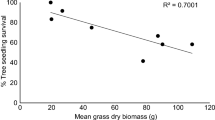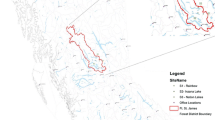Abstract
Numerous studies have quantified the responses to vegetation management in Eucalyptus plantations but most publications have reported early responses in tree growth and a gap in knowledge exist about the magnitude and duration of growth responses throughout the whole rotation. We evaluated the long-term response (9 years-old) of E. globulus across a gradient of sites to different intensity levels of free area of competing vegetation around individual tree seedlings. Competing vegetation intensity levels considered free areas ranging between 0 (control) to 2.54 m2 plus a treatment with total weed control. Competing vegetation biomass production during the first growing season was 2.9, 6.5, 2.2 and 12.9 Mg ha−1, for sites ranging from low to high annual rainfall. Across sites, maximum response in stand volume ranged between 58 and 262 m3 ha−1 at age 9 years and was proportional to the amount of competing biomass controlled during the first growing season. Total competing vegetation control showed the largest response in stand volume at sites with 2.9 and 12.9 Mg ha−1 of competing vegetation. However, the 2.54 m2 vegetation control treatment showed the maximum response for sites with 2.2 and 6.5 Mg ha−1 of competing vegetation. The duration of response for vegetation control treatments ranged between 5 and 9 years. However, at the site with the largest accumulation of competing vegetation biomass the response to vegetation control showed a sustained and divergent response. Our results suggest that vegetation control improved site resources acquisition increasing long-term stand productivity by reducing environmental limitations to tree growth differentially at each site.





Similar content being viewed by others
References
Adams P, Beadle C, Mendham N, Smethurst P (2003) The impact of timing and duration of grass control on the growth of a young Eucalyptus globulus Labill plantation. New For 26:147–165
Albaugh T, Allen L, Dougherty P, Johnsen K (2004a) Long term growth responses of loblolly pine to optimal nutrient and water resource availability. For Ecol Manag 192:3–19
Albaugh T, Rubilar R, Alvarez J, Allen L (2004b) Radiata pine response to tillage, fertilization, and weed control in Chile. Bosque 25:5–15
Albaugh T, Alvarez J, Rubilar R, Fox T, Allen L, Stape J, Mardones O (2015) Long-term Pinus radiata productivity gains from tillage, vegetation control, and fertilization. For Sci 61:800–808
Allen L (1996). Effects of site preparation and early fertilization and weed control on 14-year loblolly pine growth. NCSFNC report N°36. Forest Nutrition Cooperative, Department of Forestry, NCSU, NC, p 35
Allen HL, Lein S (1998) Effects of site preparation, early fertilization, and weed control on 14-year old loblolly pine. In: Proceedings of the southern weed science society, 51, Birmingham, AL, USA, 26–29 January, pp 104–110
Álvarez J, Allen L, Albaugh T, Stape J, Bullock B, Song C (2013) Factors influencing the growth of radiata pine plantations in Chile. Forestry 86:13–26
Balandier P, Rapey H, Ruchaud F, De Montard FX (2002) Agroforesterie en Europe de l’Ouest: pratiques et expérimentations sylvopastorales des montagnes de la zone tempérée. Cah Agric 11:103–113
Balandier P, Collet C, Miller J, Reynolds P, Zedaker S (2006) Designing forest vegetation management strategies based on the mechanisms and dynamics of crop tree competition by neighboring vegetation. Forestry 79:3–27
Booth TH (2013) Eucalypt plantations and climate change. For Ecol Manag 301:28–34
Casper BB, Jackson RB (1997) Plant competition underground. Annu Rev Ecol Syst 28:545–570
Coll L, Balandier P, Picon-Cochard C (2004) Morphological and physiological responses of beech (Fagus sylvatica) seedlings to grass-induced belowground competition. Tree Physiol 24:45–54
de Toledo R, Filho R, Bezutte A, Pitelli R, Alves P, Do Valle C (2003) Períodos de controle de Brachiaria sp e seus reflexos na produtividade de Eucalyptus grandis. Sci For 63:221–232
Dinger E, Rose R (2009) Integration of soil moisture, xylem water potential, and fall–spring herbicide treatments to achieve the maximum growth response in newly planted Douglas-Fir seedlings. Can J For Res 39:1401–1414
Dougherty P, Lowery R (1991) Spot-size of herbaceous control impacts loblolly pine seedling survival and growth. South J Appl For 15:193–199
Eyles A, Worledge D, Sands P, Ottenschlaeger ML, Paterson SC, Mendham D, O’Grady AP (2012) Ecophysiological responses of a young blue gum (Eucalyptus globulus) plantation to weed control. Tree Physiol 32:1008–1020
FAO (2013) Global forest resources assessment 2010. In: FAO technical paper. Food and Agriculture Organization of the United Nations, Rome
Flores F, Allen HL (2004) Efectos del clima y capacidad de almacenamiento de agua del suelo en la productividad de rodales de pino radiata en Chile: un análisis utilizando el modelo 3-PG. Bosque 25:11–14
Forrester D, Schortemeyer M, Stock WD, Bauhus J, Khanna PK, Cowie AL (2007) Assessing nitrogen fixation in mixed- and single-species plantations of Eucalyptus globulus and Acacia mearnsii. Tree Physiol 27:1319–1328
Garau A, Lemcoff J, Ghersa C, Beadle C (2008) Water stress tolerance in Eucalyptus globulus Labill subsp. maidenii (F. Muell.) saplings induced by water restrictions imposed by weeds. For Ecol Manag 255:2811–2819
Garau A, Ghersa C, Lemcoff J, Barañao J (2009) Weeds in Eucalyptus globulus subsp. maidenii (F. Muell) establishment: effects of competition on sapling growth and survivorship. New For 37:251–264
George B, Brennan P (2002) Herbicides are more cost-effective than alternative weed control methods for increasing early growth of Eucalyptus dunnii and Eucalyptus saligna. New For 24:147–163
Gonçalves J, Stape J, Laclau J, Smethurst P, Gava J (2004) Silvicultural effects on the productivity and wood quality of eucalypt plantations. For Ecol Manag 193:45–61
Harper G, Comeau P, Biring B (2005) A comparison of herbicide and mulch mat treatments for reducing grass, herb, and shrub competition in the BC Interior Douglas-Fir zone-ten years results. West J Appl For 20:167–176
Haywood J (2011) Influence of herbicides and felling, fertilization, and prescribed fire on longleaf pine growth and understory vegetation through ten growing seasons and the outcome of an ensuing wildfire. New For 41:55–73
Herrick JD, Maherali H, Thomas RB (2004) Reduced stomatal conductance in sweetgum (Liquidambar styraciflua) sustained over long-term CO2 enrichment. New Phytol 162:387–396
INFOR (Instituto Forestal, CL) (2014) Estadísticas forestales 2013. Boletín Estadístico Nº144, Santiago
Kogan M, Figueroa R (1999) Interferencia producida por las malezas durante los dos primeros años en Pinus radiata. Bosque 20:57–64
Kogan M, Figueroa R, Gilabert H (2002) Weed control intensity effects on young radiata pine growth. Crop Prot 21:253–257
Littell RC, Milliken GA, Stroup WW, Wolfinger RD, Schabenberger O (2006) SAS for mixed models. SAS Institute Inc., Cary
Little K (1999) The influence of vegetation control on the growth and pulping properties of a Eucalyptus grandis × camaldulensis hybrid clone. Thesis, University of Natal, South Afric
Little K, Rolando C (2008) Regional vegetation management standards for commercial Eucalyptus plantations in South Africa. South For 70:87–97
Little K, Schumann A (1996) A new systematic trial design for the optimization of interspecific weed control. In: Sheperd RCH (ed) Proceedings of the eleventh Australian weeds conference, Melbourne, Australia, Weed Science Society of Victoria, Frankston, pp 440–444
Little K, Van Staden J (2003) Interspecific competition affects early growth of a Eucalyptus grandis × E. camaldulensis hybrid clone in Zululand. S Afr J Bot 69:505–513
Little K, Rolando C, Morris C (2007) An integrated analysis of 33 Eucalyptus trials linking the onset of competition-induced tree growth suppression with management, physiographic and climatic factors. Ann For Sci 64:585–591
Mason E, Milne P (1999) Effect of weed control, fertilization, and soil cultivation on the growth of Pinus radiate at midrotation in Canterbury, New Zealand. Can J For Res 29:985–992
Nambiar EKS, Nethercott KH (1987) Nutrient and water availability to and growth of young radiata pine plantations intercropped with lupins. New For 1:117–134
Nambiar EKS, Sands R (1992) Effects of compaction and simulated root channels in the subsoil on root development, water uptake and growth of radiata pine. Tree Physiol 10:297–306
Nambiar EKS, Sands R (1993) Competition for water and nutrients in forests. Can J For Res 23:1955–1968
Nambiar S, Zed P (1980) Influence of weeds on the water potential, nutrient content and growth of young radiata pine. Aust For Res 10:279–288
Nilsson U, Allen L (2003) Short and long term effects of site preparation, fertilization and vegetation control on growth and stand development of planted loblolly pine. For Ecol Manag 175:367–377
Powers R, Reynolds P (1999) Ten-year responses of ponderosa pine plantations to repeated vegetation and nutrient control along an environmental gradient. Can J For Res 29:1027–1038
Real P (2010) Reajuste de Funciones Implementadas en Simulador EUCASIM. http://www.simulador.cl/mnsdoc/pdf/EUCA_DT12.pdf. Accessed 26 Mar 2016
Richardson B (1993) Vegetation management practices in plantation forests of Australia and New Zealand. Can J For Res 23:1989–2005
Richardson B, Davenhill N, Coker G, Ray J, Vanner A, Kimberly M (1996) Optimizing spot weed control: first approximation of the most cost-effective spot size. N Z J For Sci 26:265–275
Rose R, Rosner L (2005) Eighth-year response of Douglas-fir seedlings to area of weed control and herbaceous versus woody weed control. Ann For Sci 62:481–492
Rose R, Rosner L, Scott J (2006) Twelfth-year response of Douglas-fir to area of weed control and herbaceous versus woody weed control treatments. Can J For Res 36:2464–2473
Sands P, Landsberg J (2002) Parameterisation of 3-PG for plantation grown Eucalyptus globulus. For Ecol Manag 63:273–292
Smethurst P, Nambiar S (1989) Role of weeds in the management of nitrogen in a young Pinus radiata plantation. New For 3:203–224
Wagner RG (2000) Competition and critical period thresholds for vegetation management decisions in young conifer stands. For Chron 76:961–968
Wagner R, Petersen T, Ross D, Radosevich S (1989) Competition thresholds for the survival and growth of ponderosa pine seedlings associated with woody and herbaceous vegetation. New For 3:151–170
Wagner R, Little K, Richardson B, McNabb K (2006) The role of vegetation management for enhancing productivity of the world’s forests. Forestry 79:57–79
Watt M, Rolando C, Kimberley M, Coker G (2015) Using the age shift method to determine gains from weed management for Pinus radiata in New Zealand. Weed Res 55:461–469
Whitehead D, Beadle C (2004) Physiological regulation of productivity and water use in Eucalyptus: a review. For Ecol Manag 93:113–140
Zutter BR, Miller JH (1998) Eleventh-year response of loblolly pine and competing vegetation to woody and herbaceous control on a Georgia flatwoods site. South J Appl For 22:88–95
Zutter BR, Mitchell RJ, Glover GR, Gjerstad DH (1999) Root length and biomass in mixtures of broomsedge with loblolly pine and sweetgum. Can J For Res 29:926–933
Acknowledgements
We are grateful to Bioforest S.A. and Forestal Arauco S.A. for financial and technical support. We would also like to thank Dr. R Ahumada from Bioforest for support and useful discussions that helped the completion of this study, and Dr. H Arancibia from Universidad de Concepción for helpful comments on earlier drafts of the manuscript. Field staff from Bioforest S.A. and Forestal Arauco S.A. provided fieldwork and site management assistance, which is also gratefully acknowledged.
Author information
Authors and Affiliations
Corresponding author
Rights and permissions
About this article
Cite this article
Vargas, F., Rubilar, R., Gonzalez-Benecke, C.A. et al. Long-term response to area of competition control in Eucalyptus globulus plantations. New Forests 49, 383–398 (2018). https://doi.org/10.1007/s11056-017-9625-1
Received:
Accepted:
Published:
Issue Date:
DOI: https://doi.org/10.1007/s11056-017-9625-1




